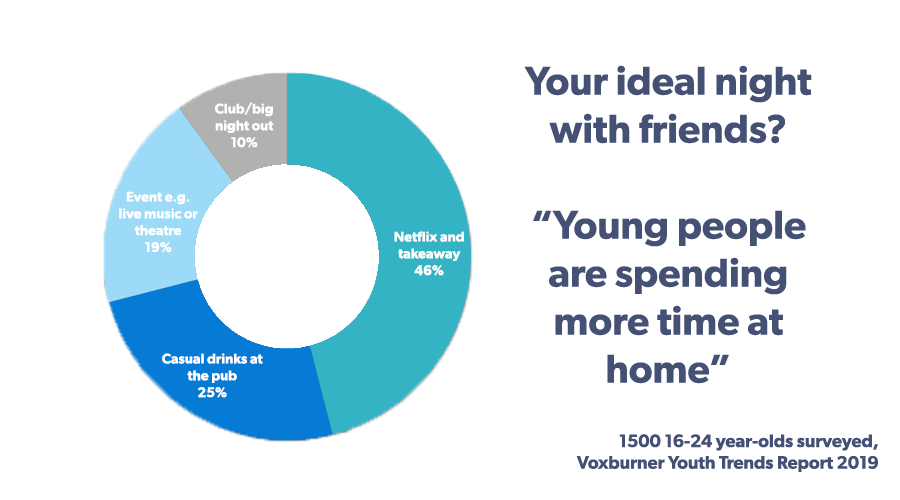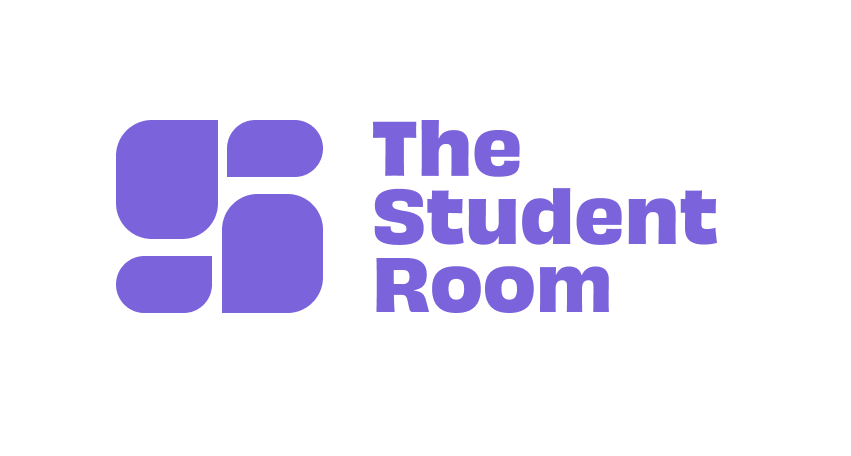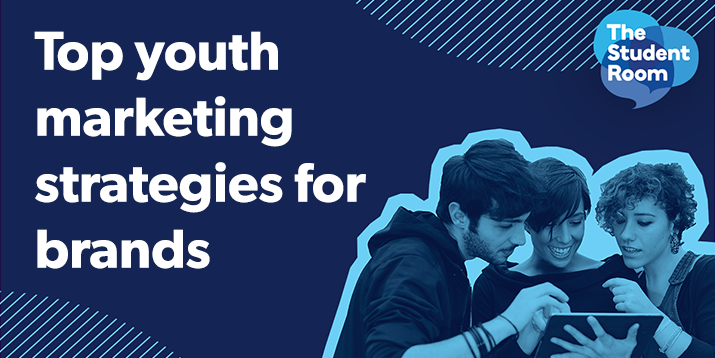Students, Gen Z, youths, the future generation. Call them what you like, they are here and they have purchasing power.
So what do they want from your brand and what kind of relationship should you build with your youth marketing strategy? We’ve pulled together the latest youth research trends to help you understand this audience and spot the ideal opportunities to engage.
Who are Generation Z?
Gen Z (born around 1995 – 2010) is often referred to as Generation Sensible because on the surface they don’t seem to party as hard as their Millenial predecessors. According to Voxburner’s Youth Trends survey, 25% of 16-24 year-olds never drink alcohol and 91% never do hard drugs.
This is a generation shaped by uncertainty and it has taught them to carefully consider their actions and purchases.
Although they will be burdened with the highest tuition fees ever, they know that even a top degree grade is no guarantee of high wages. The dream of buying their own house, almost guaranteed for Gen X graduates, seems forever out of reach for most of Gen Z. Add Brexit and the environmental crisis into the mix and it is easy to see why this generation is shouting for change.
So what does all this mean for brands?
Your brand is more transparent and your competition is global

Gen Zs have grown up with unlimited information at their fingertips. Using the internet, they can research your brand (and your competitors) at the touch of a button.
Fast delivery services like Amazon have also given consumers convenient access to a global marketplace.
This is why your brand reputation is so important. Young people have more choices than ever before, so their purchasing decisions are heavily influenced by what they read about you online.
Gen Zs will buy from your brand if it reflects their core values

92% of 16-24-year-olds would think less of a brand that harms the environment and 47% would stop buying from them. Gen Zs are using their influence and purchasing power to champion causes, protect the planet and undermine companies that make profits at any cost. Teenaged environmental activist, Greta Thunberg, is a great example:
”The problem of plastic pollution in the ocean is even worse than anyone feared. There’s actually more microplastic 1,000 feet down than there is in the Great Pacific Garbage Patch.”
We can’t continue like this.#ecologicalbreakdown #worldoceandayhttps://t.co/s3XcFbiXti
— Greta Thunberg (@GretaThunberg) June 8, 2019
In fact, The Student Room found that most students are worried about climate issues:
“80% claim they have eco-anxiety”
The new student demographic also cares about fitness, nutrition and mental wellbeing. This is good news for retail brands selling sports technology or clothing, yoga products or mindfulness apps.
When it comes to dietary choices, although only 2% 16-24-year-olds Voxburner surveyed were vegans, many more fell into a meat-reducer category for health or environmental reasons (39% have tried a vegetarian diet). This means that while catering to plant-based diets will continue to be important, food brands also need to emphasise healthy ingredients and responsible manufacturing methods.
To win Gen Zs over, demonstrate your commitment to ethical sourcing, animal welfare, reducing your carbon footprint and CSR.
But be human first! Gen Zs can smell inauthenticity a mile away. Watch this video for more in-depth analysis about Gen Z, their core values and how to participate in conversations with integrity:
Gen Zs respond to freebies and products that are easy to use

Today’s broke student is tomorrow’s loyal adult consumer and spending habits are quickly formed. Offering them discounts and incentives early on will pay-off in the long run.
Cash-poor students making buying decisions for the first time are easily swayed by savings and simplicity. For example, they will choose banks that make it very easy for them to set up new accounts, or that offer cash rewards or relevant incentives like free railcards.
But you don’t have to give things away for free to build loyalty. The Economist significantly boosted its magazine subscriptions by offering students a “12 issues for £12” discount offer. Read The Economist Case Study
Target Gen Zs with home entertainment goods or experiences
The Voxburner Youth Trends survey found that GenZ is a JOMO (Joy Of Missing Out) demographic:
We see hundreds of threads on The Student Room asking about night in activities:
- “Any good series to watch after exams? gimme a list guys”
- “Met a girl who’s coming round for a ‘movie night’ has anyone got any recommendations for a good film to watch?”
- “What do you normally get when ordering takeaway”
Technology has always been integrated into their lives, allowing them to order food at the tap of a button, access quality entertainment with the rise of streaming services and connect with friends in a digital space from the comfort of their homes.
Take advantage of this trend by selling Gen Z products that will enhance their nights in, such as gaming technologies with social digital interaction, TV subscription packages and home delivery or takeaway services.
To encourage GenZ to go out, offer them memorable experiences, meaningful human interactions, and great opportunities to create social content. 11% said they would go to an event if it looked good on Instagram.
You need to follow, engage and reward key influencers
There is big money in being a successful influencer. We polled over 1,000 users on The Student Room and found that one in four had a famous role model.
But it’s not just celebrities and high-profile social stars like Zoella (Zoe Sugg) who are cashing in. All Gen Zs understand the power of their own personal brand.
View this post on Instagram
Keeping up-to-date with emerging thought-leaders will give you crucial insights into what resonates with a student audience.
Savvy businesses are now working with nano influencers – individuals with smaller followings, but high engagement rates. These individuals will work hard as brand ambassadors to help you sell products because it demonstrates their value and helps them attract larger high-paying clients.
Don’t take them for granted. Nurture brand loyalty by rewarding your advocates: pay them, publically show your gratitude, engage with them regularly and send them free products or event tickets.
There is long-hanging fruit on these key activity days:
Results Day

Neurological studies have found that emotions drive most of our purchase decision making. On Results Day, many successful students will make a symbolic purchase to mark this important life stage. For brands, this means it’s a great time to promote high-value reward items like technology, luxury bags, or shoes.
If your brand is a restaurant or takeaway business, Results Day also represents the ritual of the celebration meal. Whether it’s proud parents taking their child for a special dinner or groups of school friends celebrating together, it is a good time to promote student deals, new menus or discount vouchers.
Don’t forget to market to the parents too. We know 29% of parents pay for their children’s technology purchases and that during this time they’ll be even more generous as they reward their children’s hard work.
However, don’t make the mistake of assuming the parents are choosing the products. 88% of students told us that even if someone else paid for the purchases, they made the decisions themselves.
Build up to freshers week

Freshers Week is a big spending time for new students, with the average student spending £286.
Starting university gives young people a chance to experiment with a new identity, but it is also a time when students worry about fitting in. 8% surveyed admitted to buying an outfit just to take photos on social media.
Begin to ramp up your content and digital strategies so that when students look online for reassurance, fashion inspiration or product reviews they will see your brand in its best light.
More advice on youth marketing strategies
If you want more advice on promoting your brand to a young audience, we are very happy to discuss this with you. Drop us a quick message and we can help you with further insights and campaign strategies.
Why not sign up to our mailing list to get the latest updates, offers and research on students?
Author: Katie Hale

